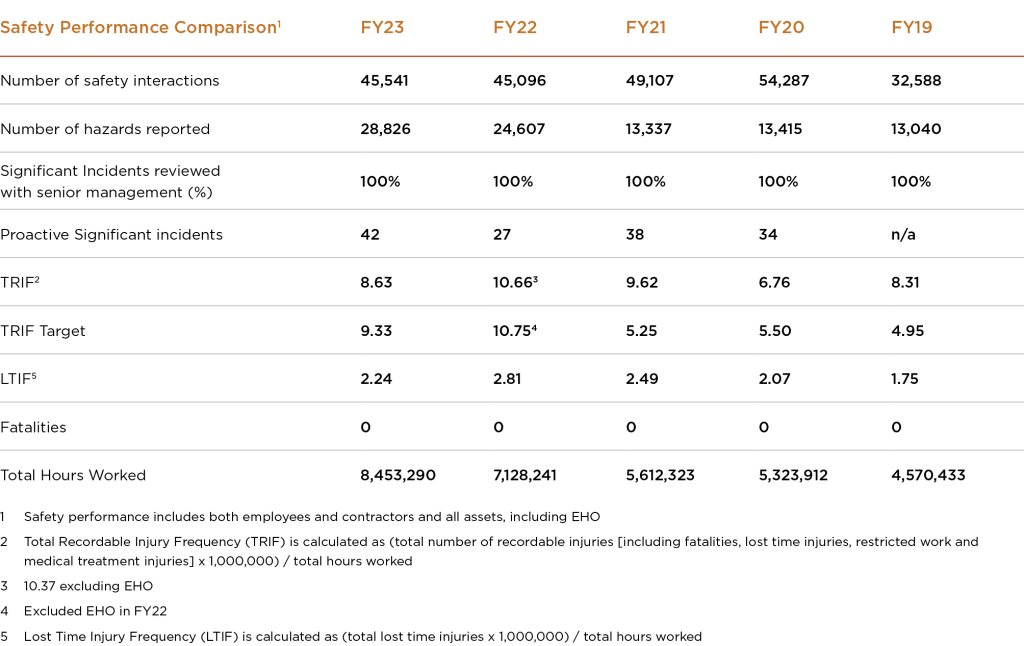Health, Safety and Wellbeing
We aspire to create a workplace where people go home even better than how they arrived. That’s what success looks like - where people are healthy and safe, where they have a voice and can contribute – at work, home and in the community.
Management Approach
Health, Safety and Wellbeing has long been a core value and strategic priority for Evolution. We are committed to providing workplaces and supporting communities where our people, including contractors and business partners, are physically and psychologically safe, healthy,
and well. By operating in Tier 1 locations, our security and geopolitical risks are minimised. In FY23, there were no work-related fatalities or permanent disabilities for operations under Evolution’s control.
We take a holistic and iterative approach to risk identification and management to provide a healthy and safe environment for all people working with us. We apply risk management principles that seek to eliminate risk where reasonably practicable, and/or within agreed
risk tolerability levels. This process is supported through appropriate risk identification and assessment, the ongoing review and improvement of risk, and the active management and verification of associated critical controls to ensure the controls are adequate, in place and appropriately applied. We aim to continuously improve health and safety performance, reduce incident frequency and prevent the recurrence of incidents. We believe every injury is preventable, with an ambition that we create a workplace where people can thrive and contribute – where people go home better than when they arrived.
Continual improvement requires a collective effort across all levels of the organisation. It is the accountability of Management to provide a healthy and safe workplace supported by all of Evolution’s workforce that must, as a condition of employment, comply with health and safety requirements, supported by systems and processes, including the Sustainability and Strategic Planning Policy, and the associated Standards.
The workforce remained actively involved in health and safety throughout FY23 through daily communications, participating in working groups, crisis management teams, business improvement initiatives, and health and safety committees. All activity sought ongoing engagement and consultation, supported by designated employee health and safety representatives.
Our performance is measured using a combination of lead and lagging indicators, with performance targets established during the annual business planning cycle. A primary lagging indicator used is the TRIF. TRIF is a Group-wide key performance indicator (KPI) and achievement of our annual safety targets forms part of the remuneration package for employees and executives. Other lagging indicators include LTIF and The Injury Severity rate which looks at the average of lost time days compared across all incidents that resulted in lost
time injuries. All frequencies are calculated based on a 1,000,000 work-hours formula aligned with OSHA principles. Leading indicators are measured and reported monthly, including proactive reporting ratios, training compliance rates, field interactions, investigation closure
data and action close out data.
By continually striving to improve the health and safety of our work practices through collaboration we have a direct and positive effect on our stakeholders, including our employees, contractors, suppliers, business partners and those who live and work in our communities.
Governance, risk management & assurance
A strong health and safety culture is supported by a structured governance process all the way from the Board, the Leadership Team, to site management across the business. The Board has oversight of Evolution’s health and safety, and overall Sustainability performance, including risk management. The Leadership Team is accountable for developing the strategy and implementing health & safety systems and processes to deliver performance standards, with General Managers accountable for performance at each operation. We
have Health and Safety committees at each operation to support the leadership in decision making, risk assessment, monitoring performance, and ensuring widespread sharing of Health and Safety information.
Health and Safety Improvement Plans have been implemented at all operations to achieve continuous improvement in performance aligned with the Risk Management Framework. These plans establish clear accountability for safety and health performance, detail the controls and practices for minimising hazards, and support effective planning and execution of health and safety systems. There is also a requirement for regular, at minimum monthly, reviews and updates of these plans, informed by worker feedback. The FY24
plans also include an increased focus on critical control management for material and critical risks.
Maintaining our culture requires both care and operational discipline supported by an engaged and capable workforce who understand the risks most relevant to them and how these are best controlled. Key mechanisms include:
- Leadership Training: Annual site inductions, values training and leadership essential training. It is an expectation linked to targets and plans that Management undertake regular field safety interactions and participate in inspections and audits
- Daily pre-start briefings: Each department hold briefings prior to each shift to discuss the activities. They review how the work will be done safely and reliably and incorporates recent incident learnings, action close outs and other information relevant to the safe conduct of work
- Monthly safety toolbox meetings: Education and awareness campaigns on a range of safety topics such as food safety, vehicle incidents, hand injuries, fatigue management or the safe handling of tools
- Regular safety inspections: All equipment, tools, and personal protective equipment (PPE), are inspected at the start of each shift to ensure they are fit for purpose. Workers are expected to comply with all requirements, including that they must not change or tamper with any safety device (including PPE)
- Report, Review and Learn sessions: Weekly sessions to share learnings related to incidents to prevent recurrence. It promotes learning through active storytelling supported by a two-page incident report
- Near miss reporting: Proactive reporting including any near-miss significant incidents provides early warning to prevent more serious incidents from occurring. This includes reporting for all incidents related to potential drug and alcohol use. Random drug and alcohol testing occurs across all operations, ensuring our people are fit for work and drug and alcohol free
- Investigations and Learning: Investigations, both proactive and reactive, and the sharing of outcomes are fundamental to our approach to Health and Safety. Incidents and any failure to adhere to established obligations are investigated under a fair and just system guided by Incident and Investigation Procedures and Standards. All investigations outcomes are available online and shared via a daily incident update called the “daily flash”
Each incident is thoroughly reviewed and assessed by the site Sustainability team to identify the root cause and corrective actions to prevent repeat events. The more near misses and hazards that are reported, the better we can understand the risks on site and work to manage and mitigate them.
Hazard Identification and Mitigation
Risk Register
New and existing risks are actively reviewed and managed with a strong focus on critical and material risks that could have an impact on either our strategy of being “a sustainable business that prospers through the cycle” or the strategic objectives.
Each operation is supported by a risk register that identifies the material, critical, and other risks associated with its operation. Each risk is ranked according to its potential severity and is supported by the risk source and the mitigating controls required to reduce the potential
severity to an acceptable level.
Scheduled risk reviews are conducted at a site leadership team-level and a regular review of safety management across the business is undertaken as a minimum annually, or as required. All leading and lagging indicators, and progress against targets are reviewed. Additionally, all identified corrective and preventative actions related to the lagging indicators are assessed to ensure that they remain relevant and effective or if additional mitigations are required.
In FY23, the Board endorsed a reviewed and updated Group Risk Register that identified material risks informed by our business strategy, objectives, vision and values, imperatives and expectations, as well as internal and external risk trends. Each material risk is accompanied by a Risk Appetite Statement.
The risk register sets out clear accountabilities of the relevant risk owner, risk appetite, threats, opportunities, impacts, and mitigating actions. It is reviewed at least annually by the Board, reported on monthly by Management and delivered in a format suitable for education and communication across the business. The risk register is reviewed at least annually and more frequently as triggered by the need to address any additional matters which may have been identified during a review of the performance indicators.
Incident Reporting
It is mandatory for all people working on our operations to report near-misses and incidents. Incidents are investigated at a level dependent on the potential severity determined through the Evolution Risk Assessment Matrix (RAM). Any event rated ‘Moderate’ is investigated and remedial actions identified, with any ‘High’ or ‘Material’ events investigated using a root cause analysis methodology. All investigations are recorded within the Incident Management System along with all corrective and preventative actions which are tracked and reported through to completion. Management or the Board may also request additional review on any incident.
Hazard Reporting
Hazards must be controlled, and all employees are trained in hazard identification, avoidance, mitigation and reporting. Identified hazards, including the corrective and preventative actions, are entered into a hazard reporting system that is monitored daily to track the close out of actions. Any overdue action triggers a reporting and escalation process to the relevant level of authority.
Take 5/Pre-task Assessment
Prior to the commencement of tasks, workers are required to stop and assess the job at hand to identify and control any potential hazards that may have not already been addressed. The assessment is guided by a ‘Take 5’ type checklist that assists in ensuring that all possible controls are in place to do the task safely.
Training
On average, each employee received 61.5 hours of health and safety related training in FY23. We continue to streamline the training processes, conducting analysis of training systems and onboarding process for all. The Board also undertakes annual risk training. Regular health and safety meetings are held to review key hazards and risks and required safeguards such as new-worker inductions, emergency response and evacuation drills, crisis management training, and basic hazard awareness and task familiarisation. This training is complemented by communication campaigns, community sessions where appropriate, and Site-specific performance improvement,
capability programs and cultural initiatives.
Our approach to training includes building the value of “the why”. A simple prompt that can reveal crucial safety behaviours. It includes an awareness and education component to help workers understand the importance of staying safe on site, the objectives of our policies and
procedures along with communication of procedures and standards and the dissemination of technical knowledge. Site-specific induction packages are completed prior to arriving on site. They allow operational teams to receive site-specific information and transition to site in a more streamlined manner. It is compulsory for all employees, contractors, sub-contractors and visitors at Evolution’s operations to complete a robust health and safety induction program, with two-yearly reassessment. It provides an overview of the business, vision and values; key policies and procedures; and critical health, safety and environmental management systems.
It is mandatory for all employees and contractors to also attend health and safety training relevant to their position and their operational environment. Training packages highlight the hazards associated with their position or work area and the relevant controls in place to mitigate these risks and involve a strong practical component to increase comprehension. It is reviewed regularly to ensure that the material remains relevant, and employees and contractors are refreshed periodically.
Communication
Regular health and safety bulletins and notices are displayed on noticeboards, circulated amongst the mail groups and discussed in the pre-shift meetings, and shared with communities where appropriate. The content of these notices includes topics such as updates or amendments to any policies or procedures, serious injuries or incidents and the controls implemented to prevent a recurrence, and a monthly update on safety performance against performance indicators.
A company-wide communication called the “Daily Flash” is also sent out which includes an update on incidents for the last 24 hours and a summary of the month’s performance. It is also used to share investigation findings once released as well as other important health
and safety information such as industry alerts, monthly performance reports, general communications, and shared learnings. These reports are retained and stored on the intranet to ensure all workers have full access to this information.
Performance
In FY23 we continued to build a learning and proactive culture so that people fully understand the controls in place relating to material and critical risks that keep them healthy and safe in the workplace.
Each operation implemented initiatives to help reduce the risk of incidents and to minimise the risk of injuries and illnesses. Performance was variable across the operations ranging from “Well Controlled” to “ Improvement Required”. Tailored programs and improvement plans
were designed to address the specific needs of each operation and were measured and tracked which focus on leadership, in field interactions, behaviours, critical and material actions, and identification of hazards. There has been ongoing review of material actions to ensure these are 100% closed out. This is reviewed weekly, reported on monthly and independently verified.
There was an improvement in both lead and lag indicators with a TRIF improvement of 19% against FY22. There were 73 recordable injuries during FY23, with 19 being lost-time injuries, resulting in a TRIF of 8.63. Whilst the TRIF met the 9.33 target, we continue to strive for improvement.
There was also a reduction in incidents with more significant consequences as supported by severity rate index. Improvement in leading indicators such as reporting and communication of serious incidents and their casual factors, proactive significant incident reporting, field
interactions and closure of investigations and actions on time were also identified. This trend supports an improved culture of reporting and is evidence that controls are operating to prevent the most serious consequence. This focus on risk management was supported by the
integration of the Material Risk Review process in the Assurance Program.
We are continually learning, improving, and sharing how we create safe and healthy workplace with an emphasis on preventing serious outcomes. There will be an increase in use of technology and data driven insights to reduce risk in the future.

Contractor Health and Safety
We operate a ‘one team’ approach and report and review all incidents including hazards and near misses reported from all workers, including contractors. Like all employees, contractors are required to follow safe work practices, report all incidents and stop work if they are unable to control hazards or implement robust controls to safely perform the task. Where a contractor does not follow safe practices, work
must cease until remedial actions have been taken. This may include implementing written procedures for high-risk tasks within the contractor’s scope; documenting training for all personnel; conducting fit-for-purpose audits of machinery, materials, PPE and emergency equipment used by the contractor; and re-inducting their employees to Evolution’s site safety requirements.
We communicate minimum expectations regarding contractor health and safety, and other environmental and social requirements as a component of the procurement process for all operations and projects. These expectations form an integral part of the signed agreements and subsequent contract reviews with each contractor or business partner. Communication is critical and includes clearly communicating and providing information on site specific risks, and the requirements and accountability for supervision to ensure work is undertaken safely and in line with Evolution’s Standards. We collaborate with our contractors to review how tasks are designed and undertaken.
Emergency Preparedness
Emergency response programs are in place at all operations and are rigorously reviewed and assessed to enable the business to be prepared to respond to an incident and/or an emergency. The emergency response teams comprise of workers with additional training in emergency protocols, procedures and equipment. The emergency response programs include extensive emergency drills and training,
such as mine rescue scenarios / training, fire drills, CPR first-aid training, and training in the use of hazardous materials suits and other safety equipment.
The framework above outlines how we respond to an emergency or crisis. It is supported by the Crisis Management Plan that outlines the roles, responsibilities and processes to be followed by the Group Crisis Management Team (CMT) in the event of a crisis, and/or the site Incident Management Team (IMT), both at an operational and a Group level.
FY23 has been a year where there has been an ongoing and active CMT and IMTs application with responses to floods, fires and ongoing management of COVID-19 as BAU. Poignant examples where IMTs have been established with support from a CMT include flood and rain events at Cowal, Mt Rawdon, and Ernest Henry, and forest fires at Red Lake.
The capability of 199 members in the Emergency Response Team (ERT) continued to be built to support operations and to assist the communities through significant incidents or threatening situations. Emergency response teams maintain close working relationships with
community-based emergency responders and provide additional support and resources to local responders in the event of a serious off-site incident. In cases of disaster and irregular weather events such as floods and forest fires, our emergency responders are ready and prepared to assist community-based response teams to protect workers, assets and neighbours.
Emergency Response and Crisis Management Framework
Emergency Response Action: to commence immediately to prevent loss of life, damage to the environment or property and to minimise harm
Level 1 Response: Operations Emergency Response Team (ERT) action at a site level
Level 2 Response: Incident Management Team (IMT) action from site and local external involvement
Level 2.5 Response: Customised grouping of Leadership Team (CMT sub-team), if required in support of a site, operations or exploration IMT level 2 activation
Level 3 Response: Crisis Management Team (CMT) Leadership Support and Management
The framework above outlines how Evolution responds to an emergency or crisis. This framework is supported by the Crisis Management Plan that outlines the roles, responsibilities and processes to be followed by the corporate Crisis Management Team in the event of a crisis, both at a site and at a Group level.
Wellbeing
A healthy and safe workforce supports engagement and reduces absenteeism. Health-related campaigns are regularly communicated through the previously mentioned and other channels to promote awareness, management, and prevention.
We aspire to create and maintain good social, psychological, and living conditions for the workforce and our communities. We pursue a preventative approach in promoting a healthy lifestyle by raising employees’ awareness of their physical and mental health status. The approach targets prevalent medical conditions including common noncommunicable diseases, communicable diseases, mental wellbeing, occupational hygiene and the effects of seasonal environmental changes.
Mental Health
There is an increased focus on the mental health of the workforce, complemented by legislative shifts towards psychological safety. A mentally healthy workplace is a shared responsibility between Evolution and its workforce. During the year, the following mental health
initiatives were undertaken:
- Community events including R U OK? Day, Mental Health Month, Movember, STEPtember, the Push-Up Challenge
- Engaged psychologists and specialists to run information sessions amongst our workforce and in our communities on mental health awareness, provide COVID-19 specific health information, and provide support during extreme weather events
- Supported training specific to psychological safety All employees and their families continue to have access to the Employee Assistance Program (EAP), which provides confidential solution-focussed professional counselling and confidential support to employees with personal or work-related difficulties. Benefits of both consultation types are leveraged to support the workforce. During FY23, 64 staff, and 7 family members, accessed 214 EAP sessions which represents an 11% increase in use of the system since FY22. Evolution’s annualised usage of 5.59% positively exceeds the Mining and Resources Industry annualised usage of 4.55%. General counselling on Critical Incident Response services were deployed to CGO and EHO throughout February and March in response to four Significant Incidents and in May at MRO after a Fall of Ground event. These totalled 360.75hrs.
Evolution is committed to capitalising on the benefits of an integrated care model and approach. It involves mental, physical and psychosocial health care with wellbeing initiatives, which enables assessment, treatment and management of mental health issues
focused on the individual’s needs.
Ways of Working
The way we work has continued to evolve and adapt in response to internal and external factors, including the COVID-19 pandemic. Employees are continuously supported to find new ways to connect remotely, develop and implement innovative solutions, and perform their roles with increased agility.
Evolution’s flexible work environment has been enhanced, aided by employee-defined ways of working charters, and the provision of wellbeing leave.
Fatigue Management
We recognise the risks associated with employee and contractor fatigue and the responsibility in providing the necessary resources through policies, awareness, empowerment, and tools to mitigate the risks.
As part of employees’ duty of care requirements, all individuals have an obligation to arrive to work in a satisfactory physical, mental and emotional state. It is regularly communicated that every employee is empowered to stop work that they consider hazardous and to report without prejudice, any issues of fatigue to their supervisor.
Accommodation areas are structured to ensure that welfare needs are addressed and that there is suitable rest between shifts by implementing noise and time curfews.
To ensure that the controls in place are effective, a fatigue investigation checklist is completed for all incidents potentially related to fatigue to identify improvements in fatigue management. This is supported by mandatory fatigue training undertaken as part of induction prior to arriving to any operation.
Transport Safety
Management Approach
The risk related to transport safety (road and aviation) varies based on the activities and locations of the operations, including exploration, and the local environments in which we operate. These activities include the movement of people, delivery of products or transporting goods and equipment.
Minimum standards have been developed to define key requirements related to transport safety and are outlined within the Aviation
and Travel, and Fixed and Mobile Equipment Standards held under the Sustainability Performance Standards. Vehicle Interaction and Aviation have been identified as material risks at a Group level which require bowtie risk assessments and critical control plans to be in place. Verification activities are undertaken to verify critical controls are effective and functioning as designed.
The Sustainability assurance program incorporates verification against the two Standards and the material risk program across the business. If any deviation is identified, an action plan is developed and the nonconformance is escalated to the Leadership Team.
Aviation Safety
The Evolution Group Sustainability Team takes a lead role in managing the risks and ensuring effective control of risks associated with the Aviation and Travel Standard providing travel related security, emergency recovery and management across the business. Aviation services are reviewed and approved by Group in consultation with key industry and regulatory bodies, with external specialist support
engaged to assess specific aviation technical matters and obligations.
International SOS have been engaged to support the health, safety and security of our people as they travel internationally and domestically. Travel is registered, and people are briefed prior to departing on any medium to high-risk travel. Generally, travel is also
restricted to and from geopolitical sensitive locations. Strict governance and sign of protocols remain in place for all overseas travel with oversight and approval required from the Leadership Team.
Vehicle Safety
Our road safety approach focuses on vehicle design and condition, road design and maintenance, traffic management rules as well as driver skills and behaviour. The Evolution Community of Practice (CoP) links with our Chain of Responsibility (CoR) obligations and supports a collaborative and action-oriented forum with a shared vision to reduce vehicle interaction risks, incidents and near misses across the business. This is focused on reducing risk and improving safety outcomes through both driver behaviour and targeting technological
solutions.
Performance
100% of charter airlines in use through FY23 have undergone the required third-party audit, confirming compliance to regulatory and Evolution minimum standards. Evolution’s due diligence is supported by the BARS Program and certification process. There were no aviation related events in FY23.
Vehicle Collision or Rollover is a Group material risk monitored at the Group level. Robust action plans have been developed to ensure critical control verification and management, which are tracked and reported on through site risk review meetings and findings, will also be linked for learning to the CoP for Vehicle Safety.






